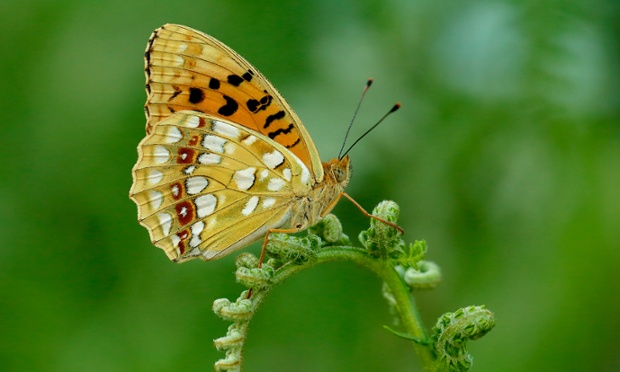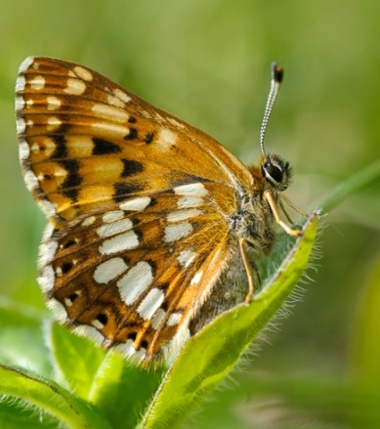The critically endangered high brown fritillary had its best summer in a decade in 2014, with numbers rising 180% in a year thanks to conservation efforts

The high brown fritillary butterfly was once common in woodlands across England and Wales. Photograph: Iain H Leach/Butterfly Conservation
Patrick Barkham
The most endangered butterfly in Britain enjoyed its best summer for a decade last year after highly focused conservation efforts on its 30 remaining sites.
Numbers of the critically endangered high brown fritillary increased by 180% last year compared with 2013 according to the UK Butterfly Monitoring Scheme (UKBMS), with warm spring weather also helping its caterpillars survive.
Its recovery, which builds on an increase in numbers in 2013, raises hopes that this large, dynamic butterfly is no longer heading towards extinction.
As recently as 50 years ago, the high brown fritillary was a common sight in large woods across England and Wales. In recent decades, lepidopterists have puzzled over its dramatic disappearance, fearing it would become the first butterfly species to fall extinct in Britain since the large blue was lost in 1979.
But according to Tom Brereton of Butterfly Conservation, recent “fine-tuning” of conservation management in the high brown fritillary’s last remaining strongholds – Morecambe Bay in Lancashire and Exmoor and Dartmoor in the south-west – has revived its fortunes.
“There’s quite a lot of fine-tuned, targeted management on many of these sites,” said Brereton. “The sites being managed specifically for the high brown fritillary are where this butterfly did well last year.”
The high brown fritillary’s caterpillars feed on wild violets found on moorland, wood edges and rough pasture. The loss of traditional grazing in many areas has seen these flowers shaded out by scrub – clearing this, and controlling bracken growth, is required for both the violets and the butterfly. Then there must be precisely-timed livestock grazing in early summer to help the female butterflies locate the violet leaves on which to lay their eggs.
Even with two good years, however, the high brown fritillary has still declined by 62% since 1978. Brereton said climate change as well as habitat loss was contributing to its decline. Like many butterflies, the high brown fritillary spends the colder months as a hibernating caterpillar, and these die if winters are warm and wet.
“It is not doomed, but the long-term prognosis is that the weather is making it harder to manage for this butterfly,” said Brereton. “We will need to work harder to get the management right in the future.”

Numbers of the threatened Duke of Burgundy butterfly also increased in 2014. Photograph: Geoff Robinson/Butterfly Conservation
The second-most endangered butterfly in Britain, the Duke of Burgundy, also rallied in 2014, according to the butterfly monitoring scheme, which is run by Butterfly Conservation and the Centre for Ecology and Hydrology.
The Duke of Burgundy recorded a 26% increase in numbers compared to the previous year, similarly benefitting from areas of farmland under EU environmental stewardship schemes, as well as co-ordinated conservation management by charities including Butterfly Conservation, the National Trust and the Wildlife Trusts.
Last summer was better than average for butterflies with more than half the 56 British species studied recording a rise in numbers compared to 2013, which was an improvement on 2012, the worst summer on record for butterflies.
Among the more common species, butterflies whose caterpillars feed on grass did particularly well last year after warm, sunny weather with some rain promoted luxuriant grass growth early last summer.
The marbled white and ringlet, which both feed on grass, experienced their best years since the UKBMS began in 1976, and the grass-feeding large skipper was also up by 86% on 2013. The brimstone also recorded its best year since records began.
But cold conditions in August caused late summer species to suffer, with the large and small whites down by more than 65% on 2013, the chalk hill blue down 55% and the Adonis blue down 43%.

